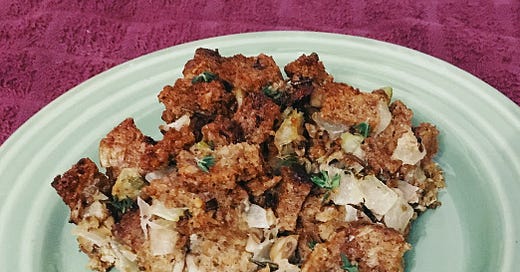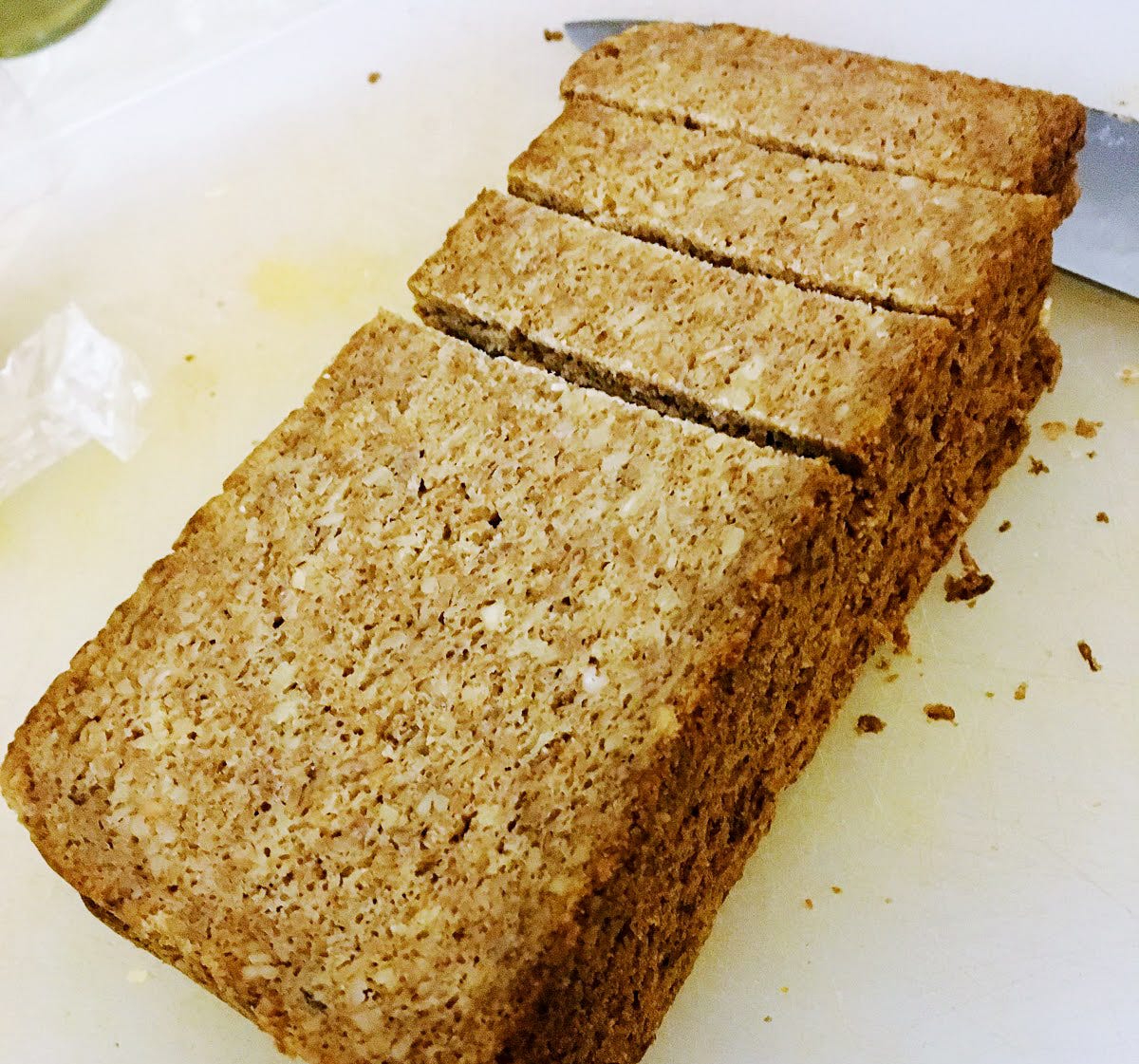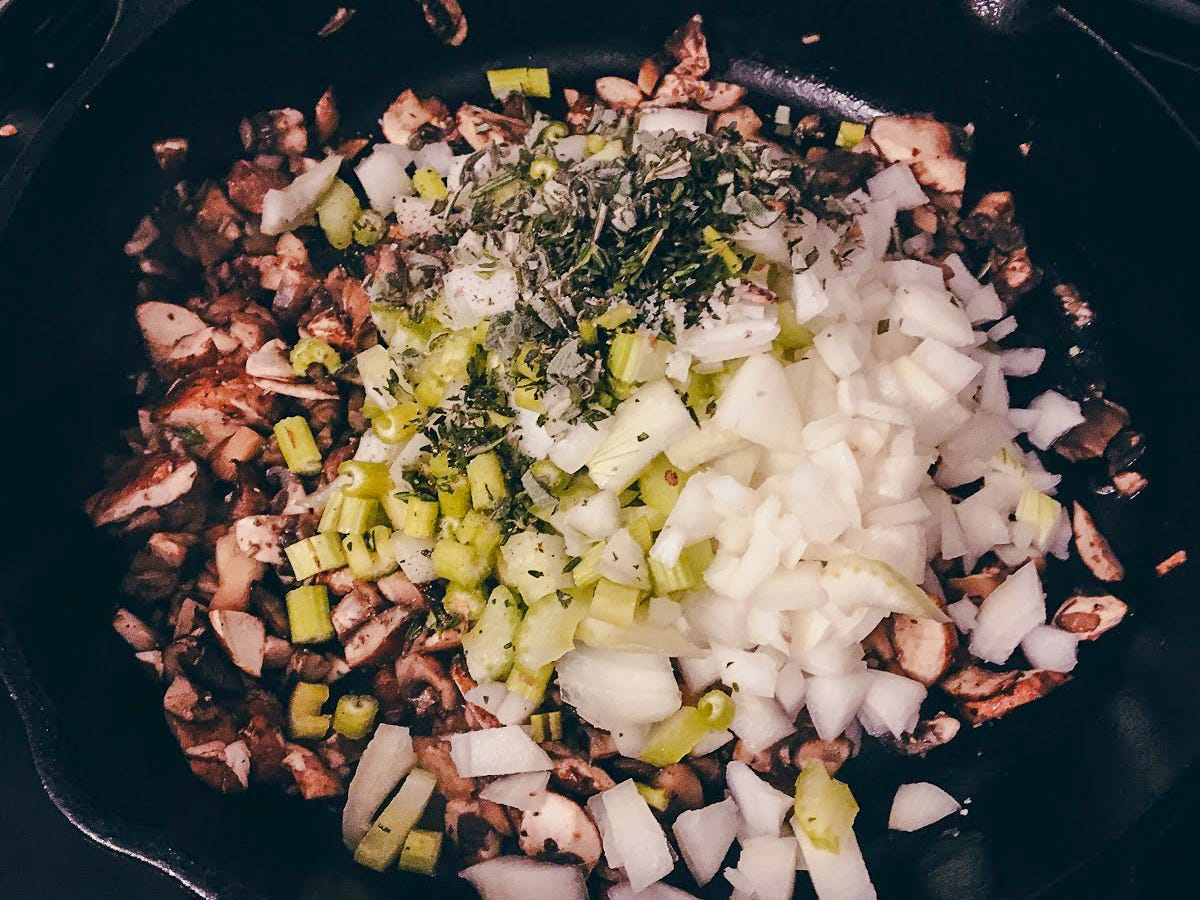Fitness Bread Dressing.
Addressing a quixotic product and transforming it into something not just edible but appealing. And remember: if it’s not in the bird, it’s dressing, not stuffing.
INGREDIENTS
1 Package of fitness bread
8 oz mushrooms, any kind but white, finely chopped
1 tablespoon mild cooking oil
1 onion, finely chopped
2 stalks celery, chopped
2 teaspoons minced fresh sage
2 teaspoons minced fresh thyme
1 teaspoon minced fresh rosemary
1 cup mushroom broth, room temperature (recipe at the end)
2 eggs, beaten
5 tablespoons butter, melted
Salt and pepper
TOOLS
2 baking sheets, lined with a silicone baking mat or parchment
Skillet
Small glass mixing bowl or 2-cup Pyrex
Large mixing bowl
9x9 baking pan
INSTRUCTIONS
Set the oven to 325. Cut fitness bread into 1 inch squares. Fitness bread is pre-sliced, so when you cut it, it will look like scrabble tiles. Bake for 15 minutes or until the squares no longer feel soft. Remove fitness bread and turn up the oven to 375.
Prepare the fresh ingredients.
Heat the skillet and oil to medium, making sure that the oil coats the entirety of the bottom of the pan. Add the mushrooms and do not touch them for at least three minutes. I understand the compulsion to stir the mushrooms but it must be resisted. Allow the mushrooms to release their liquid and then the liquid to evaporate. Then wait another moment still and then stir. This adds a little browning to the mushrooms so that they maintain their texture. This is a good approach to cooking mushrooms in general.
Add onions and celery, stirring frequently until the onions become translucent.
Add the herbs, salt and pepper to taste. Saute for three to five minutes. Remove from heat.
Move the bread and the sauteed vegetables to the mixing bowl. In the small mixing bowl, beat the eggs and the broth together. Pour the egg broth over the bread and vegetables and stir until well combined. Let sit and then gently stir once more.
Grease your baking dish. Transfer the mix to the dish.
Bake for 30 minutes.
Remove from the oven and drizzle melted butter over the top. Return to the oven for 10 to 15 more minutes, or until the bread on the top starts to brown.
Enjoy, it’s pretty good.
On Fitness Bread:
Fitness bread is one of those products that has occupied shelves of health food stores for decades, before health food stores were even worthwhile places to visit. You’ve probably never noticed fitness bread, in its little plastic package that grants the mysterious product eternal shelf life.
For some reason I’ve always wanted to try it, things like this are so fascinating to me. I want to know what it is, someone has been eating it all this time, but who? What does one do with the bread in a bag, what does it taste like, and what does it feel like to eat?
Fitness bread is a product of the company Mestemacher, which began as a little German village bakery and grew to be the global leader in rye breads. Their products are characterized by the uncanny shelf-life, even without preservatives. In addition to rye, fitness bread contains oat kernels and wheat germ. I know, this sounds incredible, right?
Well it actually is, to me. It has a firm, heavy and close texture and toasts marvelously. It has a tart, almost cheesy flavor in addition to the earthiness of the rye. On its own, it’s a little like spa food: something that tastes completely different than it looks; feels good to eat; everyone agrees that it tastes really good even though they’re not certain it does; and it’s something you would never even consider bringing into your own kitchen. The bread equivalent of the gumballs from Origins.
I thought it would do well in a dressing as a side for Thanksgiving. I guess I’ve developed a bit of a gluten intolerance and although I don’t normally do much about it, it seemed like a good idea to try to turn it into dressing.
I love projects like this. Transforming weird, alternative ingredients into something that tastes actually good is a cooking style I picked up in my three years as a vegan in the mid-2010’s. Quite like a riddle, it’s really rewarding to take knowledge of how a certain product behaves and manipulate those qualities to turn it into something completely different with a complex and delicious flavor profile.
Dressing is a great mechanism to test out how different non-gluten breads behave because half the recipe is removing the moisture from the bread and then reintroducing flavorful liquid to it. So that makes it easier to tone down some of the more aggressive aspects of the healthy, wheatless breads and reintroduce something more universally palatable. Knowing how products like fitness bread behave in different chemical circumstances is key to the process.
Also, use any mushrooms you want for this recipe. For my first trial, I used crimini. On the second attempt I used oyster, but I considered using royal trumpet and those would have worked fine. Which brings me to the mushroom broth:
I keep an enormous bag of dehydrated shiitakes on hand at all times because the little pan-Asian market in town sells them for incredibly cheap and I don’t have to worry about using them for something precious after rehydrating them like I would for, say, an $8 one ounce bag of a dehydrated forest medley.
BONUS RECIPE: BASIC MUSHROOM BROTH
Handful dehydrated shiitakes
1 stalk celery, preferably from the heart, with the leaves still on
½ yellow onion, skin still on
2 bay leaves
Salt (but really, not a lot)
Boil these in 5 cups of water on the stove for 20 minutes and then strain. That’s all. Keeps in the fridge for about a week.






I had no idea *this* was fitness bread! I thought you were referring to the lo-carb / lo-cal breads that have popped up in the grocery store since the Atkins era. This is something totally different